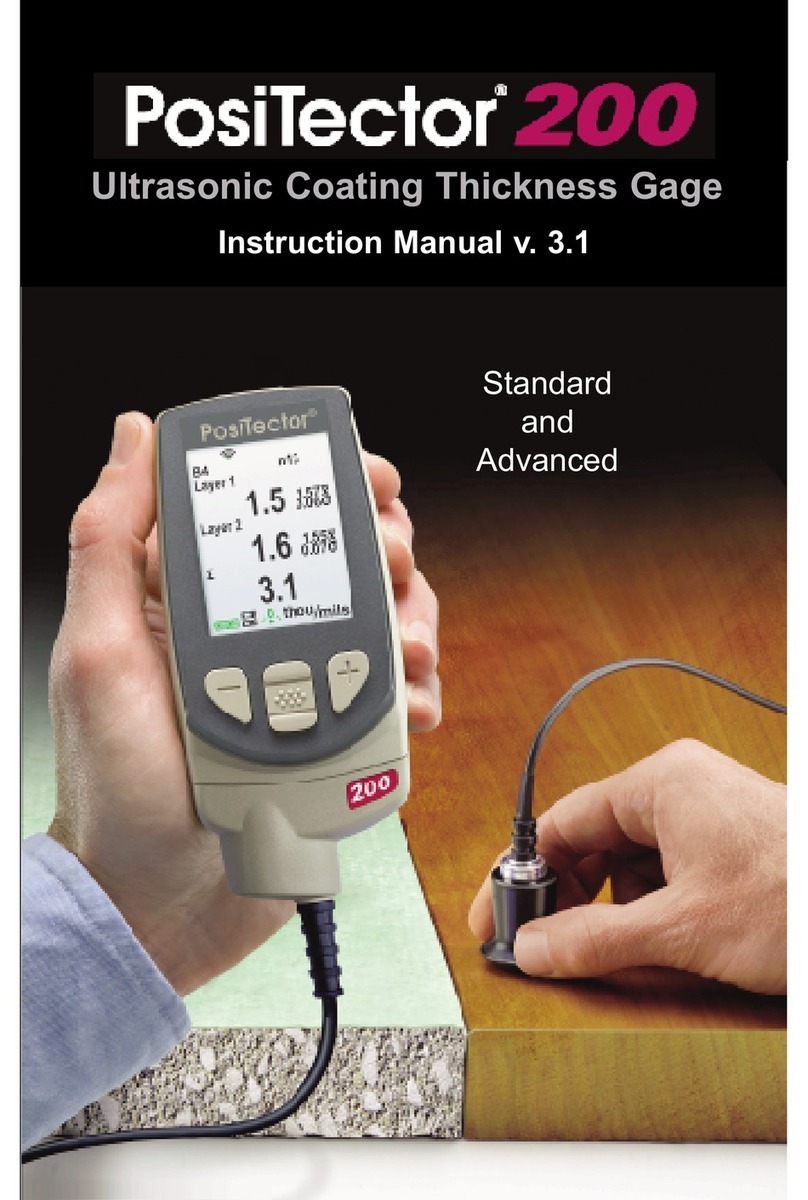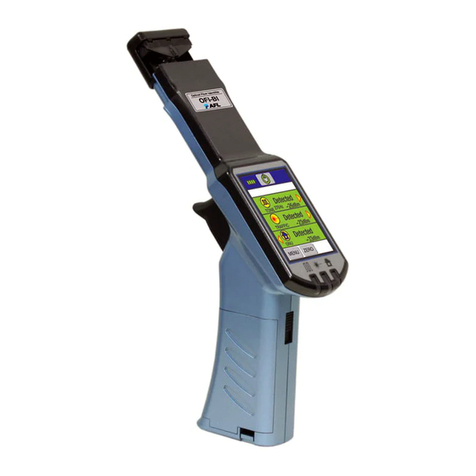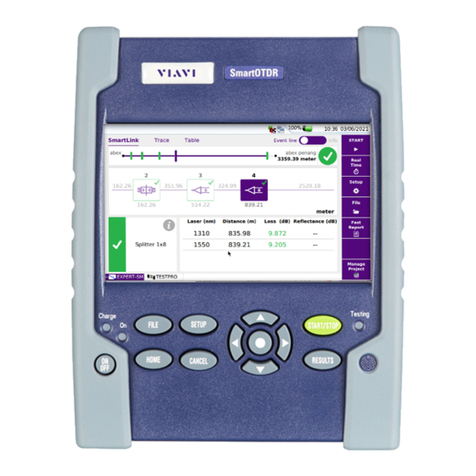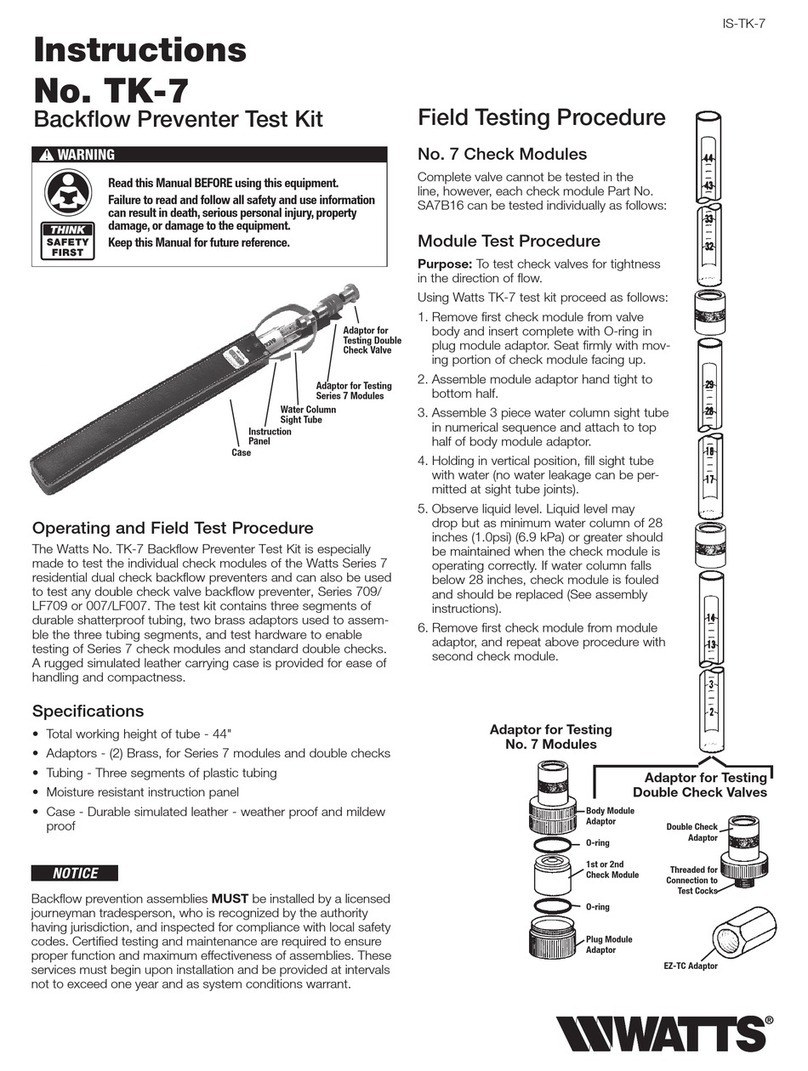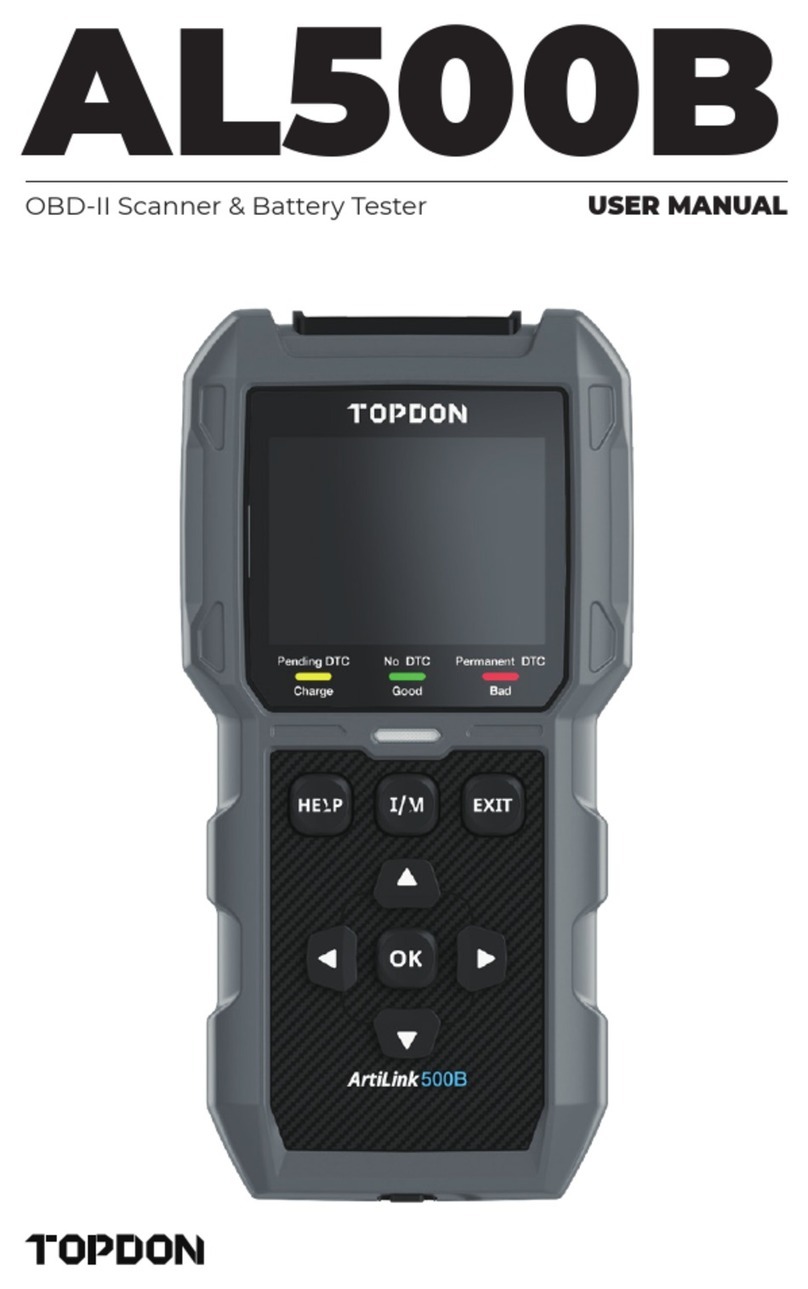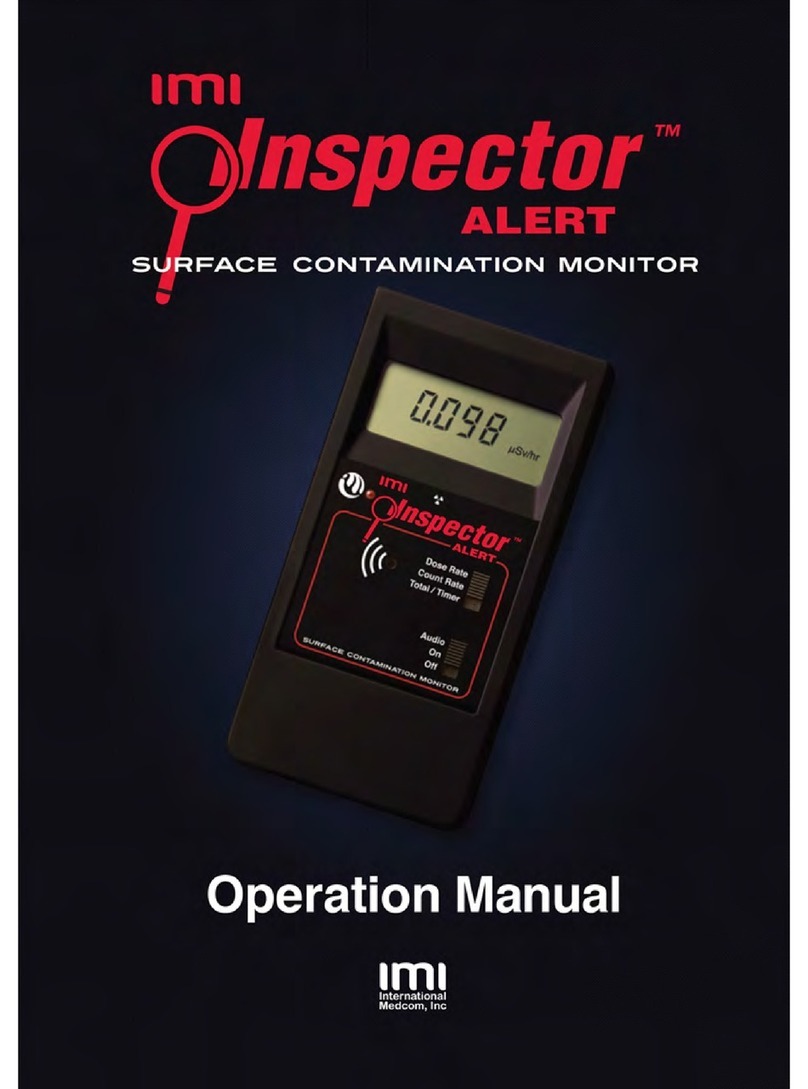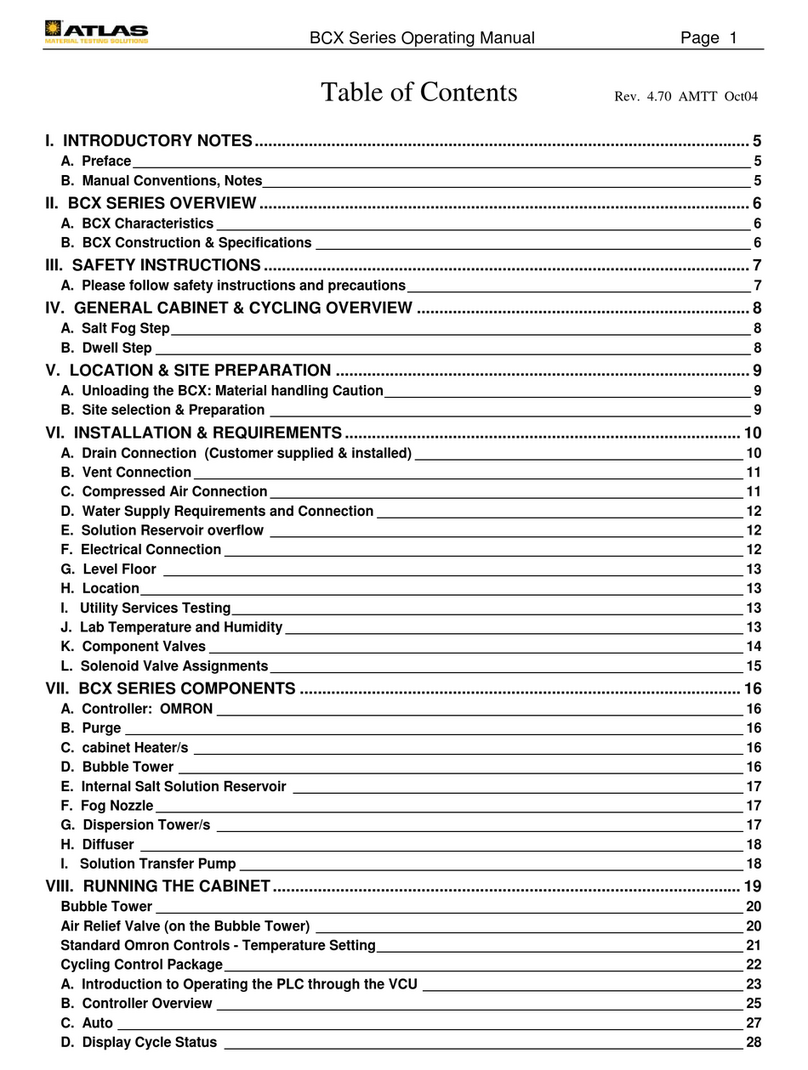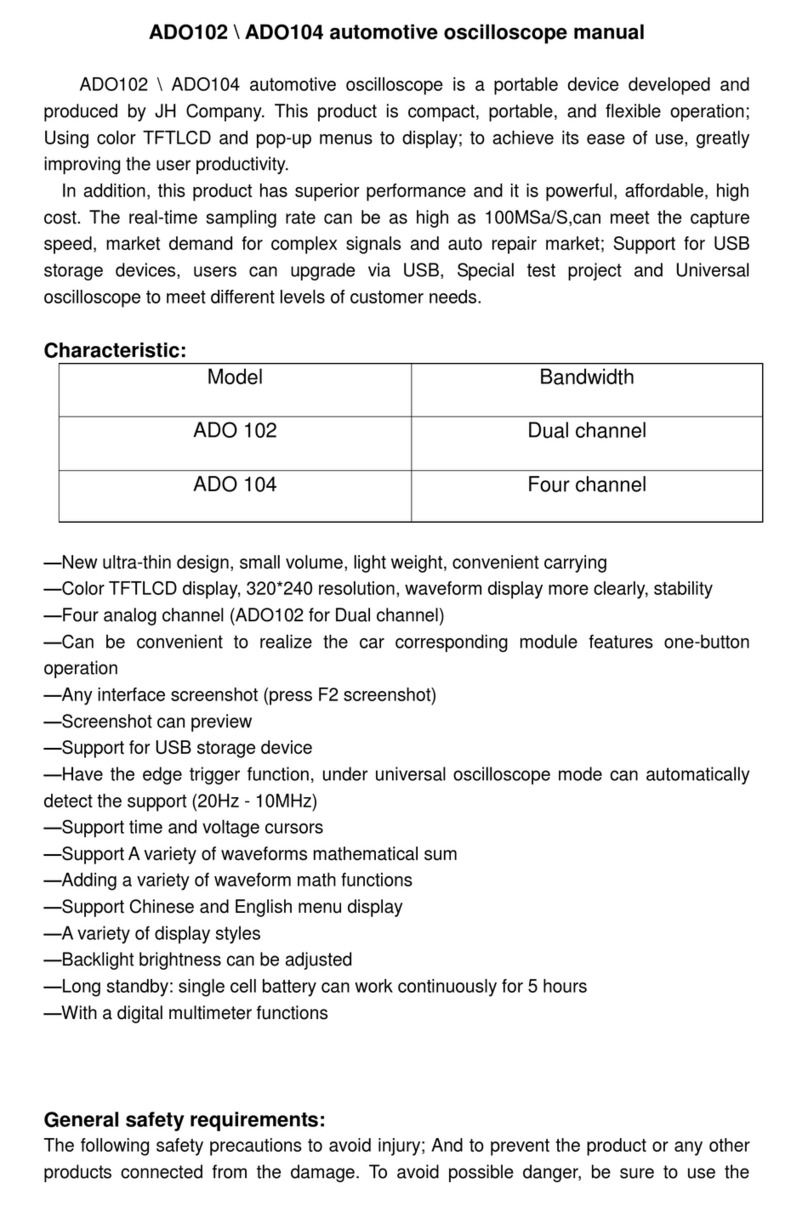DeFelsko PosiTest AT User manual

PosiTest Pull-Off Adhesion Tester
INSTRUCTION MANUAL v. 3.0
Simple. Durable. Accurate.
PosiTest AT
(manual)
PosiTest AT-A
(automatic)

Introduction
Introduction
The portable, hand-operated PosiTest Pull-Off Adhesion Tester measures the force
required to pull a specified test diameter of coating away from its substrate using
hydraulic pressure. The pressure is displayed on a digital LCD and represents the
coating's strength of adhesion to the substrate.
In accordance with ASTM D4541, D7234, ISO 4624 and others, the PosiTest
evaluates the adhesion (pull-off strength) of a coating by determining the greatest
tensile pull-off force that it can bear before detaching. Breaking points,
demonstrated by fractured surfaces, occur along the weakest plane within the
system consisting of the dolly, adhesive, coating layers and substrate.
Basic steps for testing coating adhesion with a PosiTest Adhesion Tester:
1. Dolly & Coating Preparation
The dolly and the coating are cleaned and abraded. (see pg. 4)
2. Adhesive & Dolly Application
The adhesive is prepared and applied to the dolly. The dolly is then adhered to
the coated surface and the adhesive is allowed to cure. (see pg.4)
3. Test Area Separation - Optional step
The test area of the coating is separated from the area surrounding the dolly by
cutting or drilling. (see pg. 5)
4. Pull-off Test
a) PosiTest AT (manual) (see pg. 6)
b) PosiTest AT-A (automatic) (see pg. 8)
5. Analysis of Test Results
The dolly and the coating are examined and evaluated to determine the nature
of the coating failure. (see pg. 10)
6. Store Pull-Off Test Results - Optional step
The PosiTest’s internal memory stores maximum pull pressure, pull rate, test
duration and dolly size for up to 200 pulls. (see pg. 10)
Page 3
Throughout this manual, the symbol indicates more information about
the particular topic or feature is available on our website.
Go to: www.defelsko.com/manuals
NOTE:

Step 1: Dolly & Coating Preparation
Step 1: Dolly & Coating Preparation
Dolly Preparation
1. To remove oxidation and contaminants, place the included abrasive pad on a
flat surface and rub the base of the dolly across the pad 4-5 times.
2. As required, remove residue left from the abrading process using a dry cloth
or paper towel.
Coating Preparation
1. Lightly roughen the coating using the included abrasive pad.
As coating abrasion may introduce flaws, it should only be used when
necessary to remove surface contaminants, or when the bond strength between the
adhesive and the coating is insufficient for pull testing.
2. To promote the bond between the dolly and the coating, degrease the area of
the coating to be tested using alcohol or acetone to remove any oil, moisture or
dust.
Ensure that any alternative abrasion techniques, degreasers or adhesives
do not alter the properties of the coating. Test by applying a small amount of
degreaser or adhesive to a sample area and observing effects.
Step 2: Adhesive & Dolly Application
Step 2: Adhesive & Dolly Application
Adhesive Selection
The adhesive included in the PosiTest Adhesion Tester kit has been selected due
to its versatility. This adhesive has minimal impact on a variety of coatings and has
a tensile strength exceeding the maximum performance capabilities of the pressure
system under ideal conditions. Other adhesives may be preferred based on
requirements such as cure time, coating type, working temperature and pull-off
strength. Quick curing one-part cyanoacrylates (super glues) may be sufficient for
painted surfaces, but two-part epoxies are preferred for porous or rough coatings.
Dolly Application
1. Mix the adhesive per manufacturer’s instructions and apply a uniform film of
adhesive on the base of the dolly (approximately 2-4 mils or 50-100 microns
for best results)
2. Attach the dolly to the prepared coating test area.
If the coated surface to be tested is overhead or vertical, a means to
hold the dolly in place during the cure time may be required, i.e. removable tape.
Page 4
NOTE:
NOTE:
NOTE:

Page 5
3. Gently push down on the dolly to squeeze out excess adhesive. Do not twist or
slide the dolly back and forth on the coating as air bubbles may be generated.
4. Carefully remove excess adhesive from around the edges of the dolly with
included cotton swabs.
5. Allow to cure per the adhesive manufacturer's instructions
Many adhesives cure faster and provide a stronger bond when cured with
heat. Similarly, cold environments may cause a longer cure time and weaker bond
strength.
Step 3: Test Area Separation
Step 3: Test Area Separation
Drilling Template
Cutting Instructions
1. Cut through the coating around the edges of the dolly with the included cutting
tool, removing any excess adhesive.
2. Clear away any debris from the cutting process.
-Cutting may induce coating surface flaws such as microcracking that
may alter test results.
-For coatings with strong lateral bonding it is recommended to cut
completely through the coating down to the substrate.
The decision of when to cut around a dolly is dependent on the standard,
specification or contractual agreement to which the test is to comply. The primary
purpose for cutting through the coating is to isolate a specific diameter test area.
When the decision to cut into the coating has been made, it is recommended to cut
all the way through to the substrate. As a minimum, it is suggested to carefully cut
away excess adhesive from the dolly application process. This typically prevents a
larger area of coating from being pulled away from the substrate, resulting in a
higher pull-off pressure.
When testing very thick coatings, an optional drilling template may be preferred.
NOTE:
NOTE:

CLOSE
Page 6
Quick Guide
(1) Open the pressure relief valve completely (turn counter clockwise)
(2) Connect the actuator to the dolly
(3) Close the pressure relief valve completely (turn clockwise)
(4) Zero - Press the Zero button.
(5) Pump pressure into the system until the dolly pulls the coating away
OPEN
1. Ensure the pressure relief valve on the pump is completely open. (turn
counter clockwise)
Step 4a: Pull-Off Test
Step 4a: Pull-Off Test (PosiTest AT Manual)
Pump Handle
LCD
USB port
Actuator Handle
Quick Coupling
Actuator
Assembly
Battery
Compartment
Hose
The PosiTest AT powers-up and displays dashes when the button is
pressed. To preserve battery life, the instrument powers down after 5
minutes of no activity.
2. Push the actuator handle completely down into the actuator assembly. Place
the actuator assembly over the dolly head and attach the quick coupling to the dolly
by reaching through the holes in the actuator assembly and lifting the quick
coupling. Release the quick coupling when the dolly head is completely engaged.
Pump

Page 7
3. Close the pressure relief valve on the pump completely. (turn clockwise)
As required, verify and adjust the dolly size by pressing the
button. Select the pressure units by pressing the button. The instrument
will maintain these adjustments even after the button is pressed.
4. Zero the instrument BEFORE pumping by pressing the button. This
prepares the instrument for the test by clearing the display, and zeroing the
instrument.
5. Prime the pump slowly until the displayed reading approaches the priming
pressure. The priming pressure is the point that the instrument begins calculating
and displaying the pull rate. It is also the pressure at which the ability to store
readings is enabled. Priming pressures for the various dolly diameters are:
10 mm 400 psi 2.8 MPa
14 mm 200 psi 1.4 MPa
20 mm 100 psi 0.7 MPa
50 mm 50 psi 0.4 MPa
For optimum results, prior to exceeding the priming pressure, return the
pump handle to its full upright position and then complete a single stroke at the
desired pull rate until the actuator separates the dolly from the coating.
6. Open the pressure relief valve and remove the dolly from the actuator assembly.
7. Readings may be stored into memory by pressing the button (pg. 10).
NOTE:
Troubleshooting (PosiTest AT)
Digital display “freezes” at a low value
The Tester uses a sudden drop in actuator pressure as an indication that the dolly
has been pulled from the surface. The test stops and the highest pressure remains
on the display for easy viewing and recording. Pumping up pressure too quickly at
the beginning of a test can cause a sudden pressure pulse, fooling the Tester into
thinking the test is complete. If this happens, restart the test by opening the
pressure relief valve, closing it, then pressing the button. For more
information, see Step 5 above.
NOTE:

Page 8
Dolly Size PSI Rates MPa Rates
10 mm 125, 200, 400, 600, 725 1.00, 2.00, 3.00, 4.00, 5.00
14 mm 60, 100, 200, 300, 360 0.40, 0.70, 1.40, 2.00, 2.50
20 mm 30, 50, 100, 150, 180 0.20, 0.30, 0.70, 1.00, 1.20
50 mm 5, 8, 16, 24, 30 0.04, 0.08, 0.12, 0.16, 0.20
Quick Guide
(1) Connect the actuator to the dolly
(2) Power-up with the button
(3) Verify measurement units, dolly size and pull rate
(4) Ready the instrument with the button
(5) Test with the button
1. Place the actuator assembly over the dolly head and attach the quick coupling
to the dolly by reaching through the holes in the actuator assembly and lifting the
quick coupling. Release the quick coupling when the dolly head is completely
engaged.
2. Press the button to power-up the instrument if necessary. The instrument
will power-down after 5 minutes of no activity or by holding the button for 2
seconds.
3. Check settings:
Step 4b: Pull-Off Test
Step 4b: Pull-Off Test (PosiTest AT-A Automatic)
LCD
USB port Actuator
Handle
Quick
Coupling
Actuator
Assembly
Hose
AC Adapter Port
(Charges batteries
and powers instrument)
(a) Verify displayed measurement units. Change with the button if
necessary.
(b) Verify dolly size with the button and change if necessary.
(c) Verify pull rate with the button and change if necessary. The following
user selectable rates are available:

Page 9
6. Remove the dolly from the actuator assembly.
7. Readings may be stored into memory by pressing the button (pg. 10).
All settings and test results in memory are retained during power-down.
The red button may be pressed to stop the pull test at any time. The
maximum pressure value will remain on the display while the pump retracts the
actuator. This value can be stored into memory and will be uniquely identified by
the optional PosiSoft software. Stopping the pull test before destruction is handy
when specifications allow the test to be stopped when required adhesion strengths
have been exceeded. Uncouple the actuator from the dolly and then remove the
dolly from the surface with a sharp, sideways hammer tap.
Troubleshooting (PosiTest AT-A)
CAUTION: To avoid injury, keep fingers away from the quick coupling and
actuator assembly until the pull test has completed and the actuator has
been fully retracted. Press to stop the pull test at any time.
Instrument is unresponsive or will not power down
In the unlikely event that the PosiTest becomes unresponsive or will not power
down, press and hold the button, then press the button. The
instrument will power down.
Stage 1. Initiation - the display shows a blinking "0".
Stage 2. Priming - the pump applies initial pressure to the dolly.
Stage 3. Test - when the priming pressure has been achieved (see step 5 on
pg. 7) the instrument begins calculating and displaying the pull rate
established by the user. Pressure build-up stops when the dolly is pulled from
the surface or when the button is pressed.
Stage 4. Retraction - the maximum pull-off pressure value blinks on the
display while the pump retracts the actuator. The buttons are locked during
this stage.
4. Press the button to ready the instrument. This prepares the PosiTest
for the test by clearing the display and zeroing the instrument.
5. Press the button again to start the test that consists of 4 stages that
occur automatically:

Page 10
Step 6: Storing Pull-Off values into Memory
Step 6: Storing Pull-Off values into Memory
The PosiTest’s internal memory stores maximum pull pressure, pull rate, test
duration and dolly size for up to 200 pulls.
Press the button upon completion of a test to store pull-off test results. The
display will show the pull rate and alternate between the test number and the
maximum pull pressure for that test. The icon will appear to indicate that there
are test results in memory.
Press the button repeatedly to view previously stored test results. The
PosiTest AT-A also displays dolly size and pull rate by pressing their
respective buttons.
Complete information on all test results can be downloaded to a PC and viewed
using the optional PosiSoft software. Test results are not erased from memory after
downloading. Press (AT manual) or (AT-A automatic) to exit viewing
mode.
To remove all stored test results from memory, press and hold the or
button, then press the button. The icon will disappear from the
display.
All settings and test results in memory are retained during power-down.
Test results can be considered 100% valid when the coating is completely removed
from the substrate. When only a portion of the coating is removed, specific results
should be noted including the fracture pattern to determine the cohesive properties
of the coating and adhesion properties between the dolly and adhesive, adhesive
and coating, distinct coating layers, and coating and substrate.
Step 5: Analysis of Test Results
Step 5: Analysis of Test Results
Available Options
Available Options
A variety of accessories are available to help you get the most out of your PosiTest
Pull-Off Adhesion Tester.

Page 11
Technical Data
Technical Data
Power Supply / Low Battery Indicator
Power Supply / Low Battery Indicator
PosiTest AT (manual)
Power Source: AAA alkaline batteries
As the batteries become weak the symbol will
appear on the LCD. The batteries should be
replaced at the earliest opportunity.
USE ONLY AAA ALKALINE BATTERIES. Nickel-cadmium and nickel-metal
hydride rechargeable batteries will work but the low battery symbol may stay on.
PosiTest AT-A (automatic)
Power Source: Built-in rechargeable NiMH battery (>200 pulls with full charge)
The symbol will appear when remaining battery power is below 35%.
The built-in rechargeable NiMH batteries are charged using the included AC power
supply/charger. Ensure batteries are charged prior to use. The symbol will
blink while the instrument is recharging and disappear when fully charged. The
charging process will take 2-3 hours depending on remaining battery power.
Alternatively, the AC power supply can be used to power the instrument.
The USB port will not charge or power the PosiTest. The USB connection
will drain battery power when connected for an extended period of time.
Conforms to: ASTM D 4541, ASTM D 7234, ISO 4624 and others.
Specifications:
2AAA
alkaline batteries
NOTE:
*requires optional 50 mm accessory kit
Resolution: 1 psi (0.01 MPa)
Accuracy: ±1% Full Scale
Adhesion
Strength
Dolly Size (mm) Max Pull-Off Pressure
10 mm 10,000 psi (70 MPa)
14 mm 6,000 psi (40 MPa)
20 mm 3,000 psi (20 MPa)
50 mm* 500 psi (3.5 MPa)

Page 12
DeFelsko’s sole warranty, remedy, and liability are the express limited warranty,
remedy, and limited liability that are set forth on its website:
www.defelsko.com/terms
www.defelsko.com
© DeFelsko Corporation USA 2009. All Rights Reserved
This manual is copyrighted with all rights reserved and may not be reproduced or transmitted, in whole
or part, by any means, without written permission from DeFelsko Corporation.
DeFelsko, PosiTector, PosiTest and PosiSoft are trademarks of DeFelsko Corporation registered in the
U.S. and in other countries. Other brand or product names are trademarks or registered trademarks of
their respective holders.
Protection provided by the equipment may be impaired if the equipment is used in a manner not
specified by the manufacturer.
Every effort has been made to ensure that the information in this manual is accurate. DeFelsko is not
responsible for printing or clerical errors.
Returning for Service
Returning for Service
There are no user serviceable components. Any service must be performed by
DeFelsko Corporation.
If you need to return the Instrument for service, describe the problem fully and
include reading results, if any. Be sure to include contact information including your
company name, company contact, telephone number and fax number or email
address.
www.defelsko.com/support
Calibration
Calibration
The PosiTest is shipped with a Certificate of Calibration showing traceability to a
national standard. For organizations with re-certification requirements, the PosiTest
may be returned at regular intervals for calibration. DeFelsko recommends that our
customers establish the instrument calibration intervals based upon their own
experience and work environment. Based on our product knowledge, data and
customer feedback, a one year calibration interval from either the date of
calibration, date of purchase, or date of receipt is a typical starting point.
Limited Warranty, Sole Remedy and Limited Liability
Limited Warranty, Sole Remedy and Limited Liability
This manual suits for next models
1
Table of contents
Other DeFelsko Test Equipment manuals
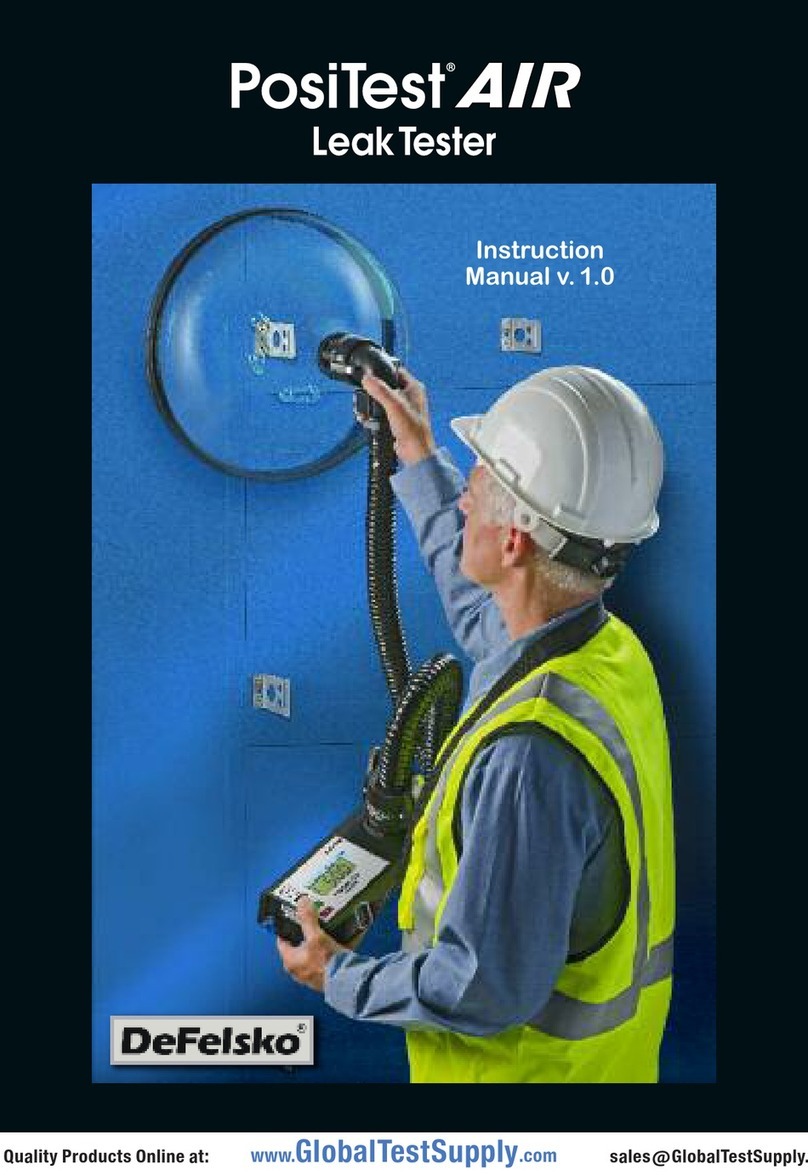
DeFelsko
DeFelsko PosiTest AIR User manual

DeFelsko
DeFelsko PosiTector SPG User manual
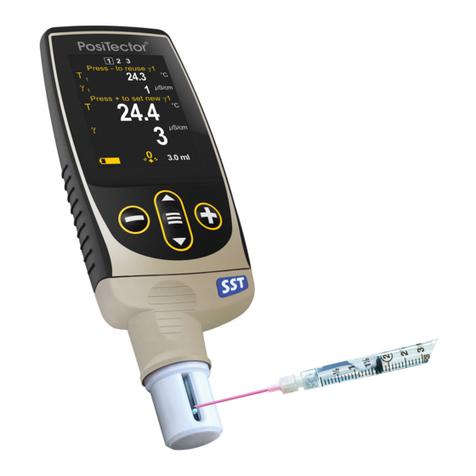
DeFelsko
DeFelsko PosiTector SST User manual
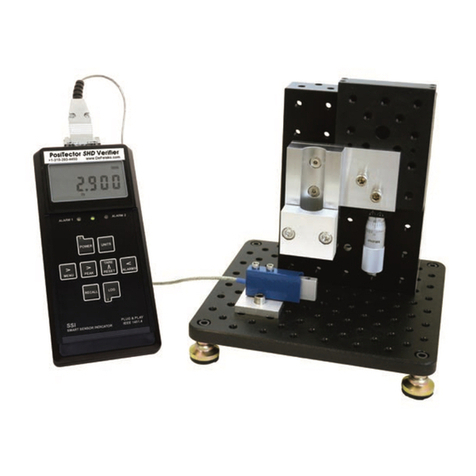
DeFelsko
DeFelsko PosiTector SHD Verifier User manual
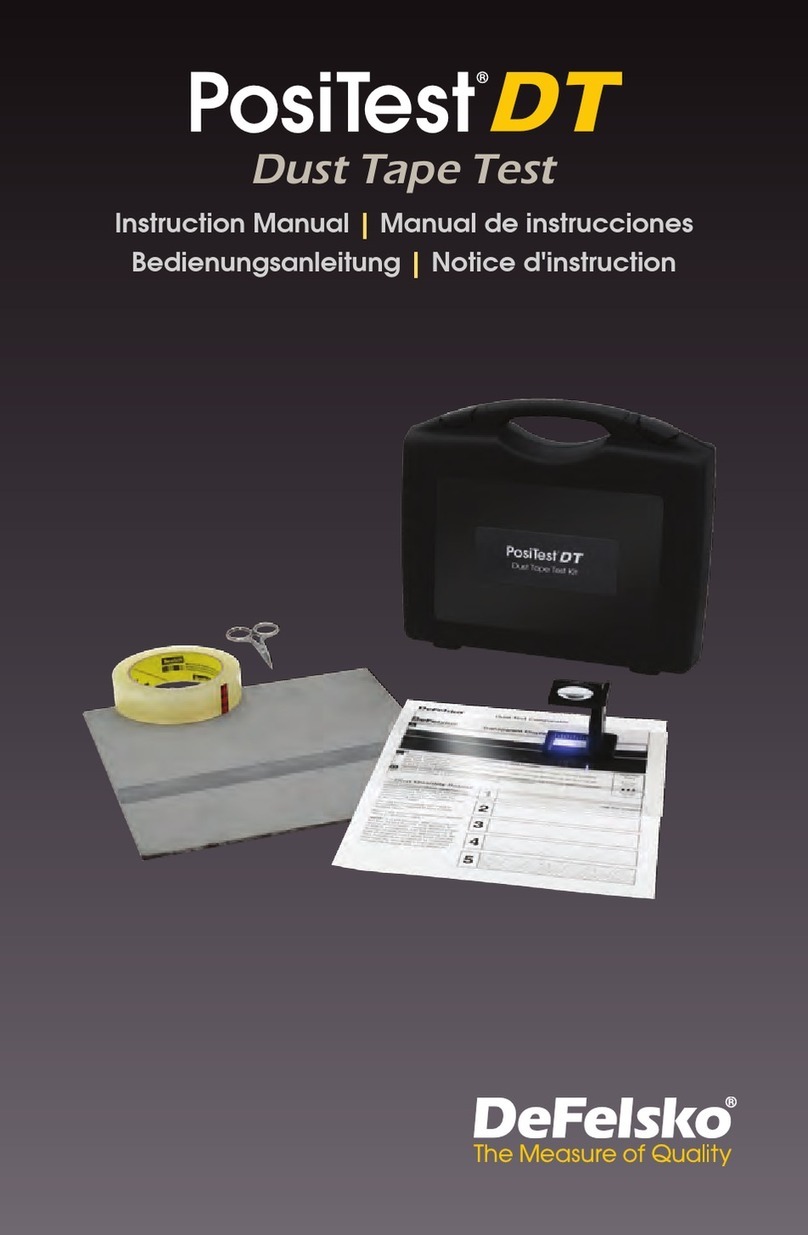
DeFelsko
DeFelsko PosiTest DT User manual
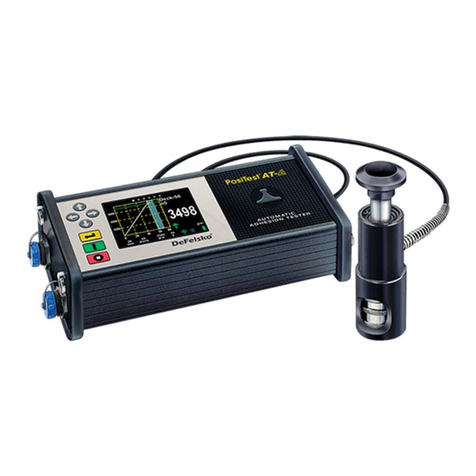
DeFelsko
DeFelsko PosiTest AT-A User manual
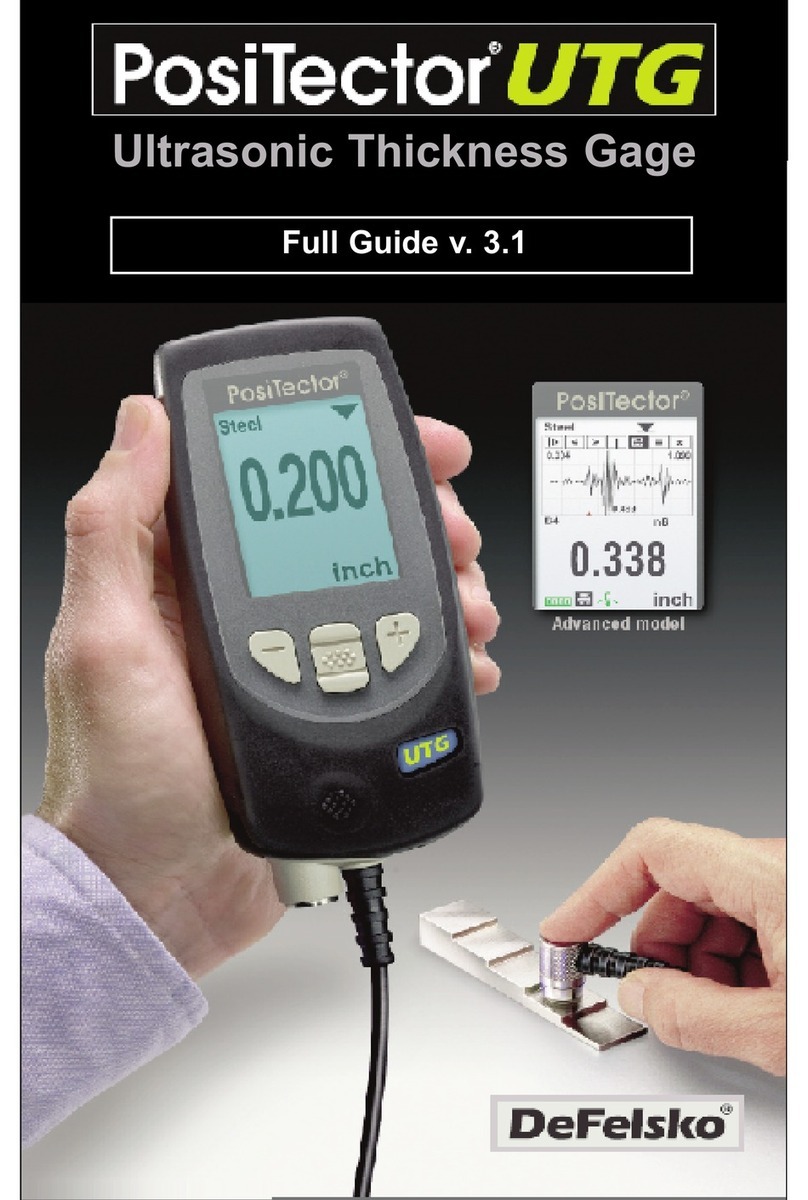
DeFelsko
DeFelsko PosiTector UTG User manual

DeFelsko
DeFelsko PosiTest AIR User manual

DeFelsko
DeFelsko PosiTest AIR User manual

DeFelsko
DeFelsko PosiTest AT-A User manual


